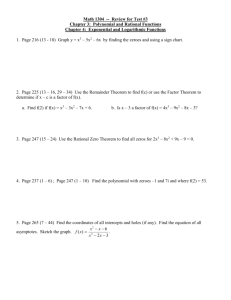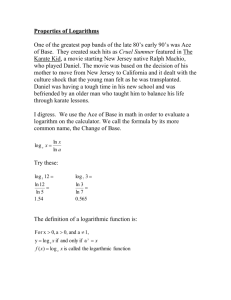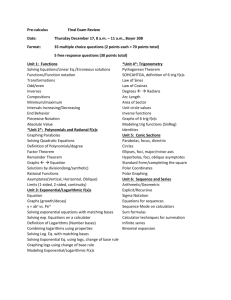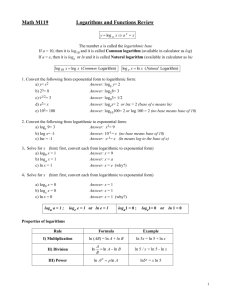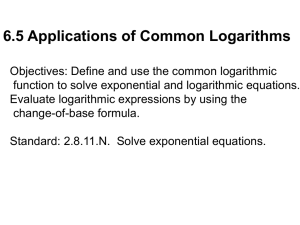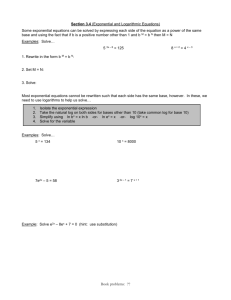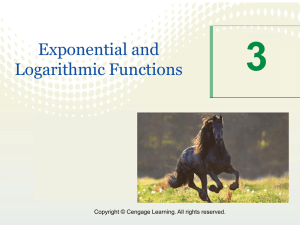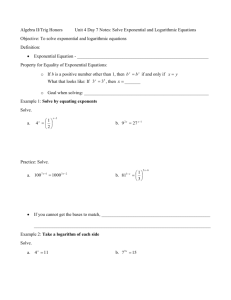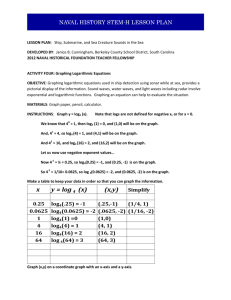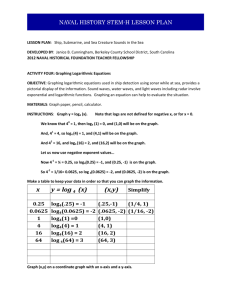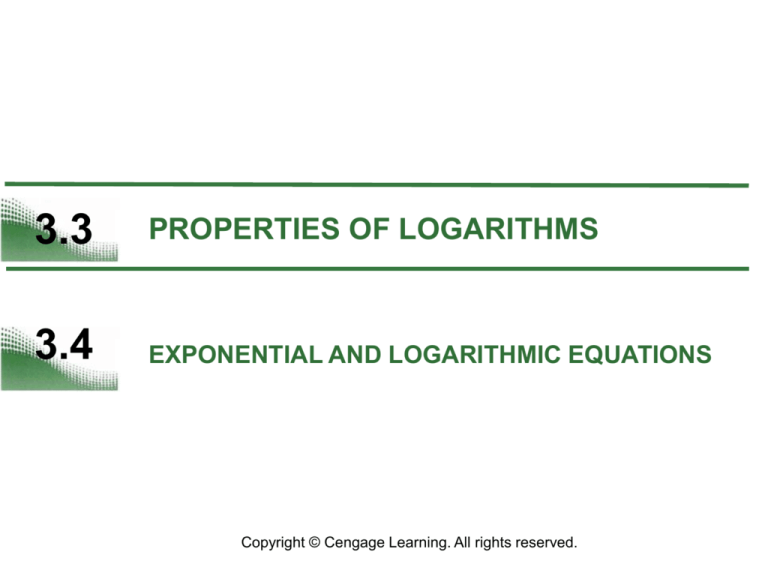
3.3
PROPERTIES OF LOGARITHMS
3.4
EXPONENTIAL AND LOGARITHMIC EQUATIONS
Copyright © Cengage Learning. All rights reserved.
What You Should Learn
• Use the change-of-base formula to rewrite and
evaluate logarithmic expressions.
• Use properties of logarithms to evaluate or
rewrite logarithmic expressions.
• Use properties of logarithms to expand or
condense logarithmic expressions.
• Use logarithmic functions to model and solve
real-life problems.
2
What You Should Learn
• Solve simple exponential and logarithmic
equations.
• Solve more complicated exponential equations.
• Solve more complicated logarithmic equations.
• Use exponential and logarithmic equations to
model and solve real-life problems.
3
Change of Base
4
Change of Base
5
Example 1 – Changing Bases Using Common Logarithms
a.
Use a calculator.
Simplify.
b.
6
Properties of Logarithms
7
Properties of Logarithms
8
Example 3 – Using Properties of Logarithms
Write each logarithm in terms of ln 2 and ln 3.
a. ln 6
b. ln
Solution:
a. ln 6 = ln (2 3)
= ln 2 + ln 3
b. ln
= ln 2 – ln 27
= ln 2 – ln 33
= ln 2 – 3 ln 3
Rewrite 6 as 2 3.
Product Property
Quotient Property
Rewrite 27 as 33.
Power Property
9
Rewriting Logarithmic Expressions
10
Example 5 – Expanding Logarithmic Expressions
Expand each logarithmic expression.
a. log4 5x3y
b.
Solution:
a. log4 5x3y = log4 5 + log4 x3 + log4 y
= log4 5 + 3 log4 x + log4 y
Product Property
Power Property
11
Example 5 – Solution
b.
cont’d
Rewrite using rational
exponent.
Quotient Property
Power Property
12
Introduction
13
Introduction
One-to-One Properties
ax = ay if and only if x = y.
loga x = loga y if and only if x = y.
Inverse Properties
aloga x = x
loga ax = x
14
Example 1 – Solving Simple Equations
Original
Equation
Rewritten
Equation
Solution
a. 2x = 32
2x = 25
x=5
One-to-One
b. ln x – ln 3 = 0
ln x = ln 3
x=3
One-to-One
c.
3– x = 32
x = –2
One-to-One
d. ex = 7
ln ex = ln 7
x = ln 7
Inverse
e. ln x = –3
eln x = e– 3
x = e–3
Inverse
f. log x = –1
10log x = 10–1
x = 10–1 =
Inverse
g. log3 x = 4
3log3 x = 34
x = 81
Inverse
=9
Property
15
Introduction
16
Solving Exponential Equations
17
Example 2 – Solving Exponential Equations
Solve each equation and approximate the result to three
decimal places, if necessary.
2
a. e – x = e – 3x – 4
b. 3(2x) = 42
18
Example 2(a) – Solution
2
–x
e
= e – 3x – 4
–x2 = –3x – 4
x2 – 3x – 4 = 0
Write original equation.
One-to-One Property
Write in general form.
(x + 1)(x – 4) = 0
Factor.
(x + 1) = 0
x = –1
Set 1st factor equal to 0.
(x – 4) = 0
x=4
Set 2nd factor equal to 0.
The solutions are x = –1 and x = 4. Check these in the
original equation.
19
Example 2(b) – Solution
3(2x) = 42
2x = 14
log2 2x = log2 14
cont’d
Write original equation.
Divide each side by 3.
Take log (base 2) of each side.
x = log2 14
Inverse Property
x=
Change-of-base formula
3.807
The solution is x = log2 14 3.807. Check this in the
original equation.
20
Solving Logarithmic Equations
21
Solving Logarithmic Equations
To solve a logarithmic equation, you can write it in
exponential form.
ln x = 3
Logarithmic form
eln x = e3
Exponentiate each side.
x = e3
Exponential form
This procedure is called exponentiating each side of an
equation.
22
Example 6 – Solving Logarithmic Equations
a. ln x = 2
Original equation
eln x = e2
Exponentiate each side.
x = e2
Inverse Property
b. log3(5x – 1) = log3(x + 7)
5x – 1 = x + 7
4x = 8
x=2
Original equation
One-to-One Property
Add –x and 1 to each side.
Divide each side by 4.
23
Example 6 – Solving Logarithmic Equations
c. log6(3x + 14) – log6 5 = log6 2x
cont’d
Original equation
Quotient Property of Logarithms
One-to-One Property
3x + 14 = 10x
–7x = –14
x=2
Cross multiply.
Isolate x.
Divide each side by –7.
24

